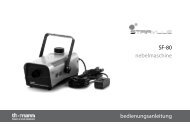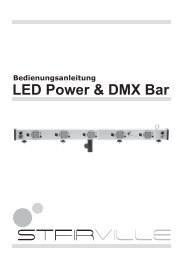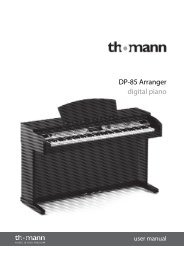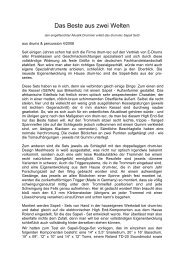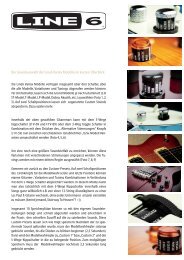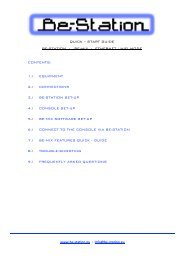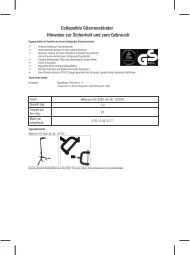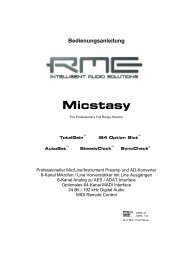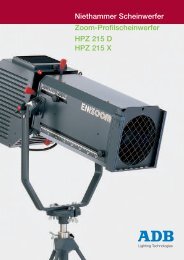You also want an ePaper? Increase the reach of your titles
YUMPU automatically turns print PDFs into web optimized ePapers that Google loves.
12:6 Mixing each part of the kit<br />
Kicks<br />
EQ<br />
The ‘low end thump’ of a kick lies in the 40-80 Hz range - many engineers refer to this as the ‘chest’ region - because you can feel<br />
it in your chest, rattling your ribcage!<br />
The main body of a kick exists in the 80-120 Hz range, with the the fundamental frequency of most kicks, depending on size, being<br />
at around 80 Hz.<br />
The body and resonance of the drum shell is found in the 160-500 Hz range. Cutting these frequencies (‘scooping the mids’)<br />
leads to a cleaner, modern kick sound, which sits well in the mix. Leaving these in is suited more to an old-school sound.<br />
The beater sound lies between 1 and 6 kHz depending on type: harder beaters tend to have more energy in the higher frequencies.<br />
Accentuate this frequency range for a modern ‘clicky’ rock kick sound.<br />
Alternatively, roll off some of the top end for a more relaxed, ‘woofy’ sounding kick, more suitable for jazzy or funk music.<br />
Mic channels<br />
The inside and outside kick mic channels sound very different to each other. The inside kick sound gives you the brighter, more<br />
aggressive sound with less low-end and some ‘shell resonance’. This is because the mic is pointed much closer to where the<br />
beater strikes the skin. The outside kick sound is much more like the kick sound as we hear it while standing next to the kit. It is<br />
often deeper in bass and less ‘attacky’.<br />
How you balance these signals is up to you, but just remember that the outside mic gives you the depth and weight while the<br />
inside gives you the attack and definition.<br />
Damping and tuning<br />
On faster songs, choose a tighter kick and use more damping. The quicker the tempo of the song, the less bass and decay you<br />
can get away with on the kicks.<br />
Tuning the kick drum to the key of the track can also help to make things gel together nicely. This is a common solution to situations<br />
where a bassline and kick are not sitting nicely together.<br />
Snares<br />
EQ<br />
The low-end ‘thump’ of a snare is usually around 100-140 Hz (depending on its size and tuning as always). Rolling off the very<br />
lowest frequencies can help a snare to cut through a mix. Also, lowering the amount of bass affects the response of any compression<br />
applied to the snare. Less bass energy means that compressors respond better to the the transients of the drum. Side-chain<br />
compression is an alternative way of dealing with this.<br />
Cutting the low mids at around 250-400 Hz ‘opens up’ the sound of the drum, while removing some mids at 700 Hz reduces the<br />
‘bark’ of the snare. The crack and attack of the snare is usually to be found between 2 to 7 kHz. If it’s any lower than 2 kHz it tends<br />
to ‘honk’. Boosting some very high frequencies at around 12-15 kHz really accentuates the ultra-high-end ‘sizzle’.<br />
If the snare is sounding too aggressive in the mid range, cutting at 1-2 kHz by 1 or 2 dB smooths it out whilst still retaining the bite<br />
and weight.<br />
Mic channels<br />
For classic pop snare sounds, use more top mic channel than bottom. For a crunchier sound use more bottom snare, which lets<br />
through more of the actual snare wire, resulting in more top end ‘crack’ and sizzle.<br />
A lot of the apparent top-end crack of a snare also comes through the overheads as well as the bottom snare channel.<br />
Damping<br />
If a snare sounds too ringy, use BFD2’s damping functions to control its decay. Introducing damping can radically alter the character<br />
and feel of a snare.<br />
Hihats<br />
EQ<br />
Rolling off the low-end on the hihats is very useful. It removes a slightly ‘gongy’ element to some hats which can often be undesirable.<br />
Cutting the low-end in this way also helps hihats to sit better in the mix.<br />
Accentuating the frequencies around 1-3 kHz tends to make the ‘stick’ aspect of the sound more pronounced, while boosting<br />
above this range, especially at 5-10 kHz, results in more of the classic hihat ‘sizzle’.<br />
1



